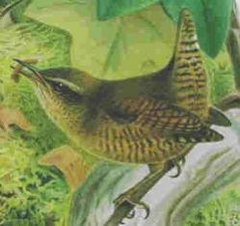Winter Wren
|
|
| Winter Wren | ||||||||||||||
|---|---|---|---|---|---|---|---|---|---|---|---|---|---|---|
 | ||||||||||||||
| Scientific classification | ||||||||||||||
| ||||||||||||||
| Binomial name | ||||||||||||||
| Troglodytes troglodytes (Linnaeus, 1758) |
The Winter Wren (Troglodytes troglodytes) is a member of the mainly New World wren family Troglodytidae. It is the only wren which occurs in the Old World. In Europe it is commonly known simply as Wren.
It is common in Europe and North America. It is only migratory in the northern part of its range. It is a very small bird, smaller than a House Sparrow and more active in its movement. It has a remarkably loud song.
The 9-10.5 cm long Wren is rufous brown above, greyer beneath, barred with darker brown and grey, even on wings and tail. The bill is dark brown, the legs pale brown. Young birds are less distinctly barred.
The plumage is subject to considerable variation, and where populations have been isolated, the variation has become fixed in one minor form or another.
Thus in the British Isles, in addition to the typical bird, there are two distinct insular forms; one, T. t. hirtensis, is confined to the island of Saint Kilda, and another, T. t zetlandicus to Shetland. The St. Kilda Wren is greyer above, whiter beneath, and with more abundant bars on the back; the Shetland Wren is darker.
Recent DNA and voclaisation studies suggest that the subspecies in Alaska and the Aleutian Islands may well be a different species from the eastern North American and European forms. The latter two populations are also genetically distinct, but possibly not sufficiently to be split as separate species. This research did not include the distinctive Scottish forms.
The small, stump-tailed Wren is almost as familiar as the Robin. It is small and mouse-like, easily lost sight of when it is hunting for food, but is found everywhere from the tops of the highest moors to the sea coast.
Its movements as it creeps or climbs are incessant rather than rapid; its short flights swift but not sustained, its tiny round wings whirring as it flies from bush to bush.
It is a bird of the uplands even in winter, vanishing into heather when snow lies thick above, a troglodyte indeed. It frequents gardens and farms, but it is quite as abundant in thick woods and in reed-beds.
When annoyed or excited its call runs into an emphatic churr, not unlike clockwork running down. Its song is a gushing burst of sweet music, loud and emphatic. It has an enormous voice for its size.
Individuals vary in volume as well as quality of song. The song begins with a few preliminary notes, then runs into a trill, slightly ascending, and ends in full clear notes or another trill. At all and any season the song may be heard, though most noticeable during spring.
At night, usually in winter, it often roosts, true to its name, in dark retreats, snug holes and even old nests. In hard weather it may do so in parties, either consisting of the family or of many individuate gathered together for warmth.
For the most part only small insects and spiders are its food, but in winter large pupae are taken and some seeds.
The male Wren has a passion for nest building, constructing more than it uses. These are called "cock nests" but are never lined until the female chooses one to use.
The normal round nest of grass, moss, lichens or leaves is tucked into a hole in a wall, tree trunk, crack in a rock or corner of a building, but it is often built in bushes, overhanging boughs or the litter which accumulates in branches washed by floods.
Five to eight white or slightly speckled eggs are laid in April, and second broods are reared. The eggs of the St. Kilda Wren are marginally larger and often more boldly spotted; six is the usual number.bg:Орехче da:Gærdesmutte de:Zaunkönig (Art) fr:Troglodyte mignon sv:Gärdsmyg
